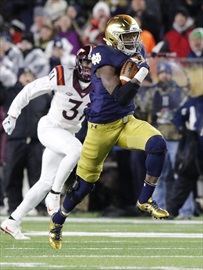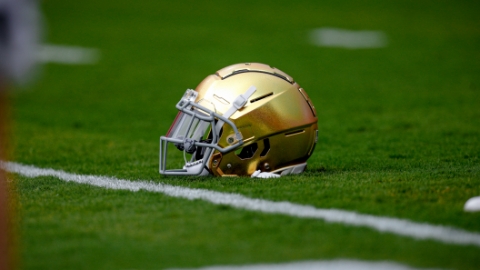
Photo by Rick Kimball/ISD
Remember: upon the conduct of each depends the fate of all.
In every football office in America there is a board with prospects names and coaches responsible for his group of athletes to recruit. Institutions possess a drive to be in constant pursuit to gather in as many top flight players as NCAA rules will allow. Some schools attack this reality more than others but all pretty much subscribe to a method in identifying and categorizing their potential recruits the same way. The architect for the modern method of discovery comes from a likely suspect, Nick Saban, and another coach that is sometimes overlooked by Saban’s huge shadow, Mark Richt. I saw this approach over 16 years ago while working as an on campus assistant to recruit visits and camps at FSU. These 3 steps where written on a board above every recruits name. At the end of every meeting they were repeated and every coach was expected to find and bring in those that matched the criteria. Notre Dame I’m sure has a similar philosophy. I believe the coaches bust their tails to seek out those types of kids, but I also believe they need a bigger staff to help identify some other smaller type of categories where some excellent players may be found. The three major points approach to separate the elite athletes from the others are as follows:
The Physical- Looks for NFL type bodies with the ability to move not only in space but have instinctive abilities to play the game at an elite level.
The Mental- Ability to learn and improve. Coachable. How a player reacts after a bad play or tough break in the game.
The Position- How an athlete fits into the position he’s being recruited and the overall scheme that’s there for that side of the ball.
 Rick Kimball/ISD
Rick Kimball/ISD
Every one of the key points above is vital to the continued life blood of a program. What is not discussed often are the sub-categories that some of your more successful staffs use to formulate who they will go after and in what order. What these coaches do is evaluate in another tier group. They don’t just broadly put the athletes in a Group A, B, or C offer pecking order; they make it much more detailed. These are some of the athletes that a larger recruiting staff, such as Notre Dame referenced above, that could benefit from seeing a wider range of player. What follows below is from some scouting I’ve gathered over the years from other coaches when looking to group recruits into these sub-categories. Keep in mind these are applicable when discipline issues are removed, that would be a separate issue and a whole article unto itself.
A1- Top 10% talent. Expected to contribute year 1. Mentally strong and with mindset needed for elite competition. Fits position being recruited for and will accent philosophy of the coaching staffs scheme.
A2- Elite talent. Possess either strong mentality to work and be coachable or fits perfect within the system for which being recruited. One of the two, while one lags behind. At times technique looks sloppy but you can see on film instinctual things you can’t coach. That reason alone sometimes makes coaches nervous because there never sure when that “instinct” will kick in. Still, you don’t turn down a commitment from this type of kid. Definite 1st or 2nd year contributor.
A3- Elite talent. Shows bad mechanics or techniques that are noticeable in film review but raw athletic ability overrides it. At times is technically sound but inconsistencies abound. Mentality losses focus in games when they matter the most, shows highlight reel stuff when game is already in hand. Physically looks the part of the position. Can play and contribute years 1-2 but with sometimes mixed results.
B1- Solid talent. Technique is often solid and mental makeup strong. Physical fit to position is mid-range as overall abilities are not as developed as Tier A player. Often very coachable and not prone to mental areas. Can compete on the field and usually see these players contribute year 2 and become solid leader rather than dominate performer.
B2- Solid Talent. Deficiencies at this level in mechanics and technique show in film study. Will note while talent is there it does not stick out on film as a dominate player. Usually after Strength and Conditioning in a big time program this player will develop more physically and with solid coaching grow into a productive player in his position that he was recruited for. Often times this is a player taken for what he can potentially become. Look for contribution year 2-3.
B3- Solid to average talent. Often players at this level play with maximum effort and make few mistakes. Coaches in recruiting process will take note of this and project he will be a coachable athlete. This type of athlete perfect technique to put him in places to make plays rather than rely on sheer athletic ability.
C- Cut off. Any coach dipping into this tier is simply filling out scholarships and hoping for the best. It is not impossible to find a “diamond in the rough” here, but often times athletically he is just not going to be able to compete no matter the technique or mentality that’s present.
Now the interesting thing here is what happens to the recruits once signed and on campus. Often times other factors play in such as academics, injuries, homesickness, coaching changes, etc…….
In the end however, it’s the coaching staff itself that has to develop them and surround them with other recruiting classes that not only add depth but compliment the tier type players that have been recruited for each positon and make sure there is a proper dynamic to develop to provide “effective” depth. Not just bodies to put on the roster. Next week I’ll start breaking down what Notre Dame has recruited this year and align it with what we already have in place. Look to see what level athlete groups with others to analyze the depth in place and see if it is solid working order. Nothing better than taking a step back to look inward and find out what you truly have. Nothing predicts the future like the present. And more importantly, what we have to look forward to.
Never miss the latest news from Irish Sports Daily!
Join our free email list
